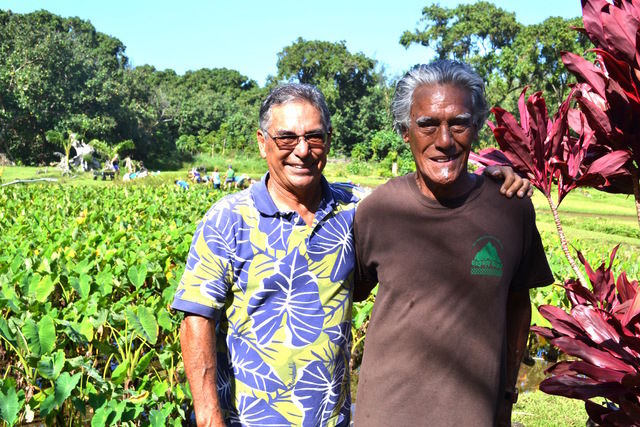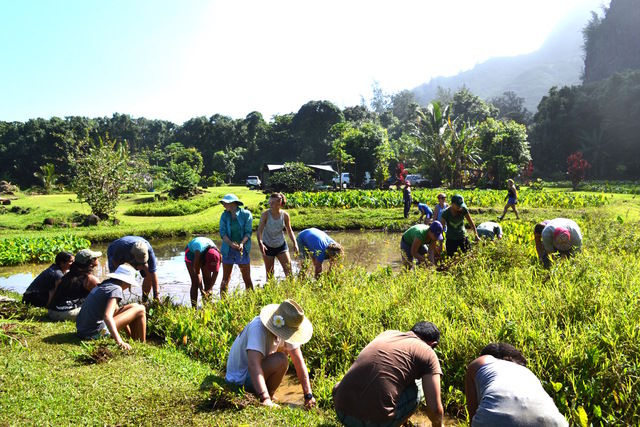HAENA — Presley Wann’s eyes always water whenever he tells his taro patch story. “To me, it was one of the great lessons in life that it wasn’t just the fact of pulling a tree out; it was the idea
HAENA — Presley Wann’s eyes always water whenever he tells his taro patch story.
“To me, it was one of the great lessons in life that it wasn’t just the fact of pulling a tree out; it was the idea of people work together with a goal in mind,” said Wann, president of Hui Maka‘ainana o Makana, a nonprofit that aims to restore Hawaiian values and stewardship practices in Haena.
In 1999, Wann and members of the hui started to clear by hand invasive plants from a taro patch which is dated to be over 1,000 years old. The hui has a curatorship with the state of about 14 acres from Limahuli Stream to Kee Beach.
By the following year, dozens more started volunteering.
In order to start up the lo‘i (taro patch), a hui kalo group consisting of kalo (taro) practitioners from all the Hawaiian islands came to Kauai to revamp the Haena site.
“This is the lower part of the ahupuaa of Haena,” Wann said. “This lo‘i serves many purposes. One of them is a natural silting basin. As time went, the water level rose, and they kept on adding on the walls. There’s a whole other layer of older lo‘i wall underneath some of (visible) ones.”
Some of the trees and stumps are on the lo‘i wall, so they aren’t disturbed because they are part of the archaeological features, Wann said.
Some, though, needed to be excavated.
In 2000, Wann and about 60 men, women and children pulled out a 30-foot Java plum tree with rope.
Wann told The Garden Island the tree had a circumference of about 3 feet, adding that he couldn’t wrap his hands around it.
“For me, I spent all my working career around heavy equipment,” he said. “I said, ‘Let me bring a machine in here.’ But they said, ‘No, we gotta dig everything out by hand.’ I (became) resigned to the fact. We tied a rope around it and we’ll try to pull it out.”
This was the first time Wann heard the chant, “I Ku Mau Mau” or “Stand Up Together.”
“When the phrase came ‘huki’ (pull), the roots lifted,” Wann said with tears in his eyes. “I know I wasn’t the only doubter. We pulled that thing right out of the ground. Just a simple thing like that, it was a real good lesson to me. You forget the power of the people when you have a common goal.”
That day, 16 years ago, was one of Mehana Vaughan’s first memories of the lo‘i.
“It represents what can happen if a community has aina in the area where their ancestors come from that they can return to and take care of,” said Vaughan, a Kalihiwai community member and University of Hawaii assistant professor who teaches natural resource management.
The lo‘i is a classroom, abundant food, something that pulls people together and keeps them close and strong, she said.
“It represents something that if every ahupuaa on Kauai had the character of our communities and the ability to keep our local families in their home, would be really beautiful and rich for the whole island,” she said. “Now I’m really lucky because I get to bring my three children.”
In 1875, 38 Hawaiians purchased this place, Wann said.
“Buying land was such a foreign concept, but they had the vision to buy this and take over,” he said.
The area was formerly known as Taylor Camp, named after Howard Taylor, Elizabeth Taylor’s brother.
“There was a situation where they had these huge groups of hippies living there … in the ‘60s and ‘70s,” Wann said. “The state started a condemnation process and they condemned from Limahuli Stream all the way to Kee.”
From the early 1970s to 1999, heavy brush and overgrowth of invasive species filled the area, prompting Chipper Wichman, Carlos Andrade and Chipper’s two uncles to clear the area and take back the land, Wann said. In 1999, the hui was formed. Uncle William Kinney Sr. is among the 20 hui members who volunteer at the lo‘i, which also protects a fishery extending a mile out from the shore.
“I love to come down to the hui and I volunteer here,” said Kinney, who frequents the lo‘i every chance he gets. “I love to help the people here and teach the young people about the lo‘i and about the ocean in front of us. We’re here to protect our natural resources in the ocean, so we can bring it back to future generations.”
Volunteers clean the lo‘i the first and third Saturday of every month, Kinney said.
“They pull the weeds and mow and weed whip,” he said. “We give away the kalo and we bring a bag of kalo to Waipa every Thursday. Other than that, anyone who comes to volunteer and help, they can take kalo home.”



